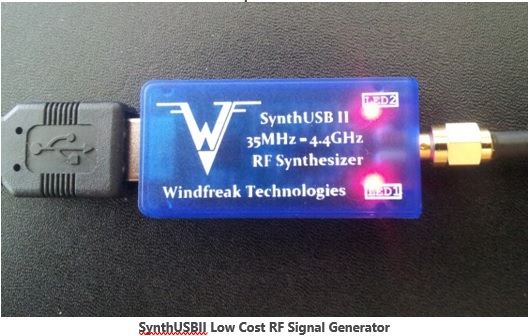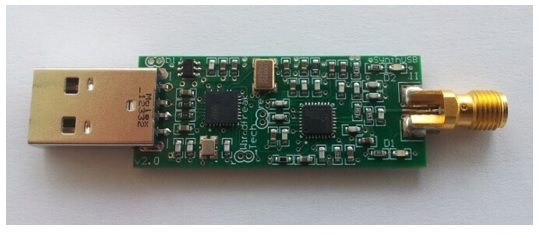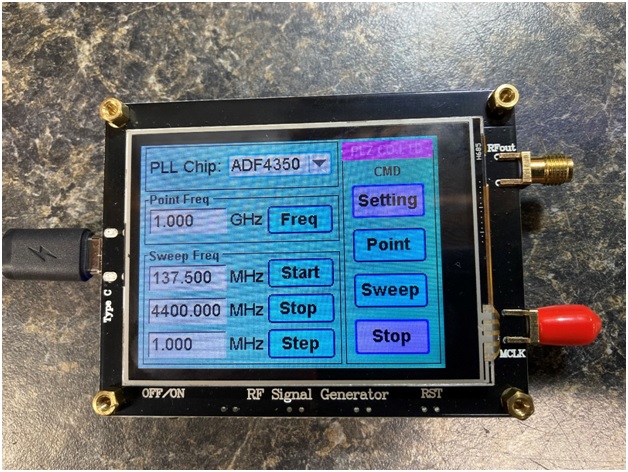It goes with out saying that most experiments in microwave electronics will require some sort of RF generator. There are many RF generators from which to choose anywhere from a benchtop laboratory signal generator to simple little modules. Likewise, the cost covers a large range. High powers are not needed because of the very high sensitivity of the measuring equipment. Staying around a milliwatt (0 dBm) is adequate and safe.
For the experiments described in this work there are many generators available at very low cost. Two of these will be considered in detail. The heart of these modules is an Analog Devices AD4350 or 4351 integrated circuit. These IC’s are members of a family of devices and they have been incorporated into some RF generators designed for the DIY experimenter. Keep in mind that building circuits that operate in the gigahertz range can be very challenging and so buying assembled building blocks like the RF generator are often the best route to successful experiments. Kits of parts and boards are also around and since the chips need a considerable amount of input data, they are three wire serial devices, making them good candidates for microprocessor control and custom software.
One microwave generator goes by the name SynthUSB II RF Synthesizer. The output is 35 MHz – 4.4 GHz with an output power of close to 1 milliwatt. As the name implies it is in the form of a USB stick and gets it power from a USB port. It is pictured in Figure 2.1.

Figure 2.1. The SynthUSB II. The plastic container is about 1” x 2”. It and other are available from Windfreak Technologies LLC.

Figure 2.2. The SynthUSBII with the cover removed. One of the large IC’s is the AD4351 and the other is a microprocessor/communication device.
The device comes with a program which allows access to many of the functions provided by the AD4351. The software was written in LabView. The source code is included on a CD and can be modified to suit specific needs. Shown in Figure 2.3 is the first of five user interface windows.

Figure 2.3. First of five user interface windows for the SynthUSB II.
The other microwave generator is very similar but uses the 4350, with a low frequency of 137.5 MHz otherwise the products are nearly identical, USB power and the same output power. The one shown in Figure 2.4 is simply labeled “RF Signal Generator” and is available on e-bay. Some of the units for sale have a lower RF limit of 137.5 MHz others are 35 MHz but the upper limits are 4.4 GHz. It has a built-in touch screen monitor that allows the user to control the device.

Figure 2.4. The e-bay RF Signal Generator. It is about 3 x 4”.
This signal generator does not have the extensive collection of functions that the SynthUSB II does. Recently, similar generators/synthesizers have been advertised with an upper frequency range of 6.8 GHz. These is a bit more expensive. Windfreak also sells generators up to 15 GHz.
Since both above units use IC’s from the same family as the basis for their function, it is not surprising that the output (see Figure 1) and user interfaces are very similar. Both have four selectable output levels. Both have outputs that are nearly flat over the output frequency range. Finally, both have functions that allow the output to be swept over a range of frequencies and rates.
As mentioned these generators have selectable power outputs. The data sheets for the IC’s indicate that the 4 setting give -4, -1, +2, +4 dBm output over the range of operations. Keep in mind that the actual power obtained from the generators will be dependent on how they are connected to the device they are driving (i.e., terminated). The data sheets indicate that these generators should be terminated with a 50 ohm load. This is common practice for microwave equipment.

Figure 1. Output as a function of frequency at full power in terms of output voltage from the logarithmic power meters described in later sections (50 ohm load).
These devices are extremely high quality and will not be the weak link in your experiments!
A Few Word About Cabling
The pictures above clearly show the predominance of SMA connectors in the microwave world. They are small and very easy to work with if you buy premade cables. These can be expensive but a handful of cables about 6-12” long is a good investment. If you are at a hamfest keep your eyes open since you can often find these in the miscellaneous boxes of the vendors. While your looking, watch for attenuators as well. More on these in latter chapters.
Microwave electronics has a bit of the Lego mentality. Lots of the simple modules fit together with short SMA cables (and 50 impedances). It really makes working with the components very enjoyable.
References
The data sheets for the AD4350 and AD4351 are available on the Analog Devices web page as well as other places on the web, just search for AD4350 or AD4351.
